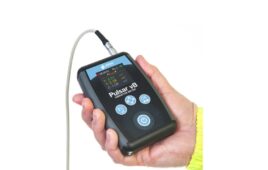In series production of vehicles, numerous production steps are automated and are performed using modern manufacturing processes based on innovative technologies. Precise sensors are indispensable in this respect. They enable high precision robot positioning, for example, when assembling the cockpit.
The vehicle bodies move in cycles to the respective position on the assembly line. The car body must stop at exactly the intended processing position. This is the only way to ensure smooth installation via the robot, which must guide the cockpit between the A and B pillars into the vehicle.
The correct position at which the car body should stop is determined by optoNCDT ILR1030-8/LC1 time-of-flight laser sensors from Micro-Epsilon. They are particularly suitable for these and other comparable applications due to their short response time. Therefore, the sensor is mounted on the robot tool. Measurements are performed at a distance of approx. 600 to 700 mm from the vehicle’s A and B pillars at a measuring rate of 100 Hz. Therefore, the sensor emits short laser pulses. When the car arrives on a belt, the laser light first hits the A-pillar and is reflected back to the sensor’s optics. The measuring system is set up in such a way that the next time it hits the B-pillar it sends an analog output signal of 4 – 20 mA to the PLC, which finally causes the line to stop. The vehicle is now correctly positioned and the gripper is activated by the PLC. The gripper now guides the cockpit between the A- and B-pillars to its intended installation position.
The sensor’s advantages include easy integration into the production line and its surface independence. With sensors from Micro-Epsilon, precise measurements are even possible on demanding black high-gloss surfaces as well as on metallic paints. Thanks to the non-contact measuring principle, the measurement object surface always remains intact.
Micro-Epsilon
www.micro-epsilon.com
Filed Under: Sensor Tips




